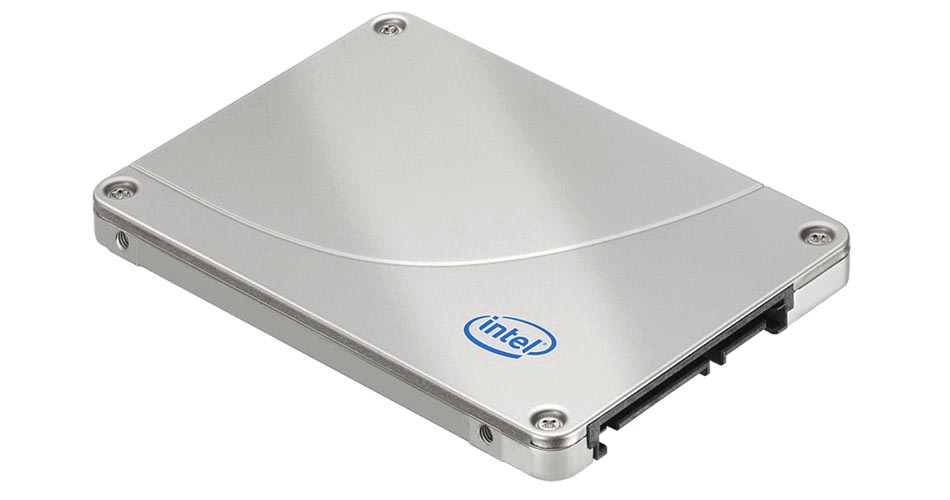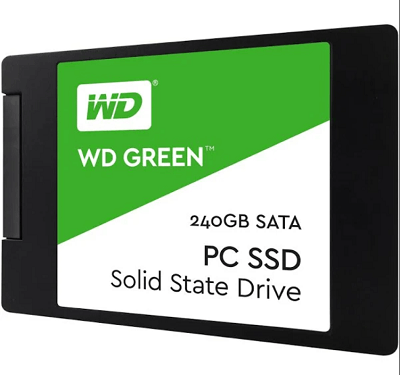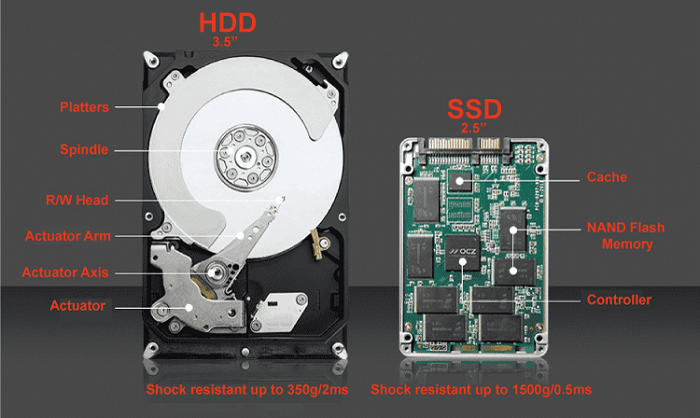What is an SSD?
SSD stands for "Solid State Drive". It is a computer storage device that uses NAND-based flash memory to store data. Unlike traditional hard disk drives (HDDs), which SSDs don't have any moving parts, thus they read and write data using spinning discs, which makes them faster, more durable, and more power-efficient. SSDs use a type of memory called NAND flash, which is non-volatile, meaning it can retain data even when power is not supplied. This makes them ideal for portable devices like laptops and tablets, where power consumption is a major concern.

History of SSD
The earliest "solid-state memory" devices, often SSDs or solid-state drives, were created in the 1970s. However, these early SSDs were extremely expensive and had limited storage capacity, making them impractical for most applications. It was not until the 1980s and 1990s that SSD technology began to be used in more practical applications, such as military and aerospace systems. These early SSDs were still relatively expensive and had limited capacity compared to traditional hard disk drives.
In the early 2000s, advances in NAND flash memory technology led to the development of more affordable and higher-capacity SSDs. These early SSDs were primarily used in industrial and enterprise applications like servers and data centers.
Around 2007, consumer-grade SSDs began to emerge on the market, although they were still relatively expensive compared to traditional hard drives. However, their superior performance and reliability made them popular among early adopters and enthusiasts. SSD technology has continued to evolve and improve in the years since, with capacities increasing and prices decreasing. Today, SSDs are widely used in various applications, from consumer laptops and desktops to enterprise-level servers and data canters.
Working of SSD
The basic working principle of an SSD involves storing data on NAND-based flash memory. NAND is a type of non-volatile memory that can retain data even when power is turned off.
When you save a file to an SSD, the data is stored on one or more NAND flash memory chips. The SSD uses a controller chip to manage data storage on the flash memory chips, and the controller chip also handles transferring and receiving data from and to the SSD.
To read data from an SSD, the controller chip sends a signal to the flash memory chip where the data is stored. The flash memory chip then sends the data back to the controller chip, which processes it and sends it to the computer's processor for use.
To write data to an SSD, the controller chip first erases the NAND flash memory cells where the data will be reported, and it then writes the new data to the appropriate memory cells. Because of the way NAND memory works, data can only be erased and written to memory cells in blocks rather than individually. This is why SSDs tend to have limited write cycles before they degrade in performance.
Overall, working with an SSD involves managing the storage and retrieval of data on NAND flash memory using a controller chip. The lack of moving parts makes SSDs faster, more durable, and more power-efficient than traditional hard disk drives.
Explain the features of SSD:
Solid State Drives (SSDs) have several key features that differentiate them from traditional hard disk drives (HDDs). Here are some of the most important parts of SSDs:
- Flash Memory: SSDs store data instead of spinning disks and read/write heads using NAND-based flash memory. This makes SSDs faster and more durable than traditional HDDs.
- Speed: SSDs are faster than HDDs regarding read/write speed, boot, and application load times. This is because SSDs do not have any moving parts, and data can be accessed almost instantly.
- Durability: Since SSDs do not have any moving parts, they are less susceptible to physical damage and are more durable than traditional HDDs.
- Energy Efficiency: SSDs use less power than HDDs, which can translate into longer battery life for laptops and mobile devices.
- Capacity: SSDs are available in a wide range of capabilities, ranging from a few gigabytes to several terabytes.
- Form Factor: SSDs are available in several form factors, including 2.5-inch, M.2, and PCIe cards. This makes them suitable for various devices, from laptops and desktops to servers and data centers.
- Price: SSDs are typically more expensive than HDDs, but prices have decreased rapidly. Additionally, the cost per gigabyte of storage for SSDs is becoming increasingly competitive with HDDs.
Advantages of SSD
- Performance: SSDs perform far more quickly regarding data access speeds. They offer shorter boot times, faster application load, and faster file transfers.
- Improved Reliability: Since SSDs have no moving parts, they are less prone to mechanical failures, such as head crashes, that can lead to data loss.
- Greater Durability: SSDs are more resistant to physical shock and damage. SSDs a good choice for portable devices, such as laptops, that may be subjected to rough handling.
- Lower Power Consumption: SSDs use less power, which can result in longer battery life for laptops and other mobile devices. This also makes SSDs a good choice for servers and data centers, where power consumption is a significant cost factor.
- Quieter Operation: SSDs don't have moving parts, producing less noise and vibration. Because of this, they are a suitable option for settings where noise levels must be maintained to a minimum.
- Smaller Form Factor: SSDs are available in smaller form factors, making them ideal for use in thin and light laptops, tablets, and other mobile devices.
- Increased Endurance: Modern SSDs are designed to last longer, thanks to advanced wear-leveling algorithms and other features that help extend the drive's lifespan.
Disadvantages of SSD
- Cost: SSDs are typically more expensive, especially for drives with larger capacities. This can make them less cost-effective for users needing much storage space.
- Limited Lifespan: While modern SSDs are designed to last longer than older models, they still have a limited lifespan. Over time, the flash memory cells in an SSD can wear out, which can lead to data loss or drive failure.
- Capacity Limitations: SSDs have limited read/write cycles, meaning they can only be written a certain number of times before they fail. This can lead to capacity limitations over time, as the driver may need to reserve more space for wear leveling and other maintenance tasks.
- Susceptibility to Heat: SSDs are more susceptible to heat damage, which can cause them to fail more quickly. This is because high temperatures can damage the flash memory cells in an SSD.
- Data Recovery Difficulties: Unlike HDDs, which may be recoverable after a mechanical failure, recovering data from a failed SSD can be much more difficult and expensive.
- Performance Degradation: SSD performance can degrade over time, especially if the drive is nearly full. This can lead to slower data access speeds and reduced overall system performance.
Types of SSD
There are various types of SSDs on the market, including:
SATA SSDs: These are the most common type of SSD and are designed to replace traditional hard drives in desktop and laptop computers. They can be installed in current systems because they share the same SATA interface as HDDs.

NVMe SSDs: NVMe (Non-Volatile Memory Express) is a high-speed data transfer protocol that allows SSDs to operate faster than SATA SSDs. NVMe SSDs are designed for high-end desktops, laptops, servers, and data centers that require extremely fast storage.
PCIe SSDs: PCIe (Peripheral Component Interconnect Express) is a high-speed interface that connects SSDs directly to the motherboard, bypassing the slower SATA interface. PCIe SSDs are even faster than NVMe SSDs and are designed for high-performance gaming and workstations.
M.2 SSDs: M.2 is a small form factor SSD that connects directly to the motherboard via the PCIe or SATA interface. M.2 SSDs are designed for laptops, ultrabooks, and small form-factor desktops.
U.2 SSDs: U.2 is a newer SSD form factor that uses the PCIe interface and is designed for enterprise-level data centers and servers.
Speed of different SSDs
The speed of different SSDs can vary depending on several factors, including the type of interface, the quality of the NAND flash memory, the controller, and the firmware. Here are some general speed ranges for different types of SSDs:
- SATA SSD: SATA SSDs typically have sequential read and write speeds ranging from 500MB/s to 600MB/s and random read and write speeds ranging from 80,000 to 100,000 IOPS.
- NVMe SSD: NVMe SSDs can have sequential read and write speeds ranging from 1,500MB/s to 7,000MB/s and random read and write rates ranging from 150,000 IOPS to 1,000,000 IOPS, depending on the specific model.
- M.2 SSD: M.2 SSDs can have sequential read and write speeds similar to NVMe SSDs, but may have lower random read and write speeds, typically ranging from 80,000 to 500,000 IOPS.
- U.2 SSD: U.2 SSDs can have similar speed ranges to M.2 SSDs and NVMe SSDs, with sequential read and write rates ranging from 1,500MB/s to 7,000MB/s random read and write speeds ranging from 150,000 IOPS to 1,000,000 IOPS.
- PCIe SSD: PCIe SSDs can have very high speeds, with sequential read and write rates ranging from 1,500MB/s to 15,000MB/s and random read and write speeds ranging from 100,000 IOPS to 1,000,000 IOPS.
- SAS SSD: SAS SSDs typically have sequential read and write speeds ranging from 500MB/s to 1,500MB/s and random read and write rates ranging from 80,000 to 300,000 IOPS.
Uses of SSD
Due to their greater performance and dependability over conventional hard disc drives, SSDs, or solid-state drives, have grown in popularity in recent years.
- Personal computers: SSDs are commonly used in personal computers as a faster and more reliable alternative to traditional hard disk drives. They can improve boot times, application loading times, and overall system performance.
- Gaming: SSDs are popular among gamers due to their faster loading times for games and reduced stuttering during gameplay.
- Servers and data centers: SSDs are widely used in enterprise-level servers and information centers due to their high performance, reliability, and lower power consumption than traditional hard drives.
- Laptops and tablets: SSDs are commonly used in laptops and tablets due to their faster boot times, improved battery life, and resistance to shock and vibration.
- Digital cameras: Some high-end digital cameras use SSDs for storage due to their speed and reliability.
- Automotive industry: SSDs are used in some automotive applications, such as infotainment and navigation systems, due to their resistance to shock and vibration.
Composition of SSD:
SSDs, or Solid State Drives, comprise several key components that work together to store and retrieve data. Here are the main features of an SSD:
NAND Flash Memory: This is the primary storage medium used in SSDs, and it consists of interconnected memory cells that store data using electrical charges. NAND flash memory is non-volatile, meaning it can retain data even when the power is turned off.
Controller: The controller is a small chip that acts as the "brain" of the SSD. It manages the data flow between the NAND flash memory and the computer's CPU and performs other functions such as wear leveling, error correction, and encryption.
Cache: Some SSDs include a small amount of high-speed DRAM memory that serves as a cache, helping to improve read and write speeds.
Interface: The interface is the connector that attaches the SSD to the computer's motherboard. The most common interfaces used in SSDs are SATA, NVMe, and PCIe.
Enclosure: The enclosure is the physical housing that protects the SSD's components from damage and provides a standard form factor for computer installation.
SSD vs. HDD
SSD (Solid State Drive) and HDD (Hard Disk Drive) are two storage devices simultaneously store data. There are, however, some significant differences between the two. The following are some of the primary distinctions between HDDs and SSDs:
- Speed: SSDs are significantly faster than HDDs regarding data access and transfer speed. HDDs use spinning discs and read/write heads, while SSDs store data in flash memory. As a result, SSDs can deliver faster boot times, application load times, and file transfer speeds.
- Reliability: SSDs are more reliable than HDDs due to their lack of moving parts. HDDs are vulnerable to mechanical failures, such as head crashes and platter damage, while SSDs are more resistant to shock and vibration.
- Power consumption: SSDs consume less power than HDDs, which can result in longer battery life for laptops and other portable devices. SSDs do not have to spin disks and move read/write heads, which requires more power.
- Capacity: HDDs are still the primary choice for high-capacity storage needs. HDDs are available in larger capacities than SSDs and at a lower cost per gigabyte.
- Price: SSDs are generally more expensive than HDDs, especially for higher-capacity drives. However, the price gap between the two types of industries has been shrinking in recent years.

How to choose the right SSD?
Choosing the right SSD depends on a few factors, such as your computer's hardware, intended use case, and budget.
- Interface: The interface determines how the SSD will connect to your computer's motherboard. The most common interfaces for SSDs are SATA, NVMe, and PCIe. Make sure to choose an SSD compatible with your computer's interface.
- Capacity: Consider how much storage capacity you need. SSDs are available in many capacities, from a few hundred gigabytes to several terabytes. Choose an SSD with enough storage capacity for your needs.
- Speed: SSDs offer varying levels of performance. Look for an SSD with faster read and write speeds if you need shorter boot times, application load times, or file transfer speeds.
- Endurance: The endurance rating of an SSD refers to how long it will last before wearing out. Look for an SSD with a high endurance rating if you plan to use it for intensive workloads or applications that involve a lot of data writing.
- Brand and reliability: Choose an SSD from a trustworthy company with a solid dependability and customer service reputation.
- Price: SSDs are available at different price points, so consider your budget when choosing an SSD.